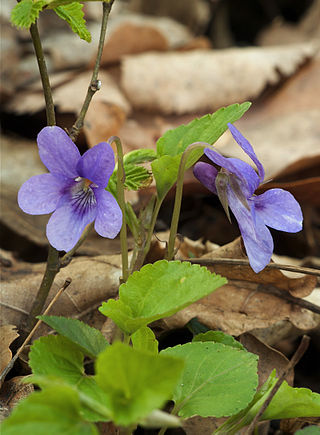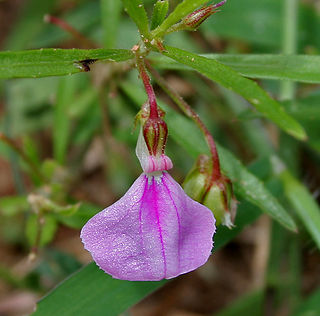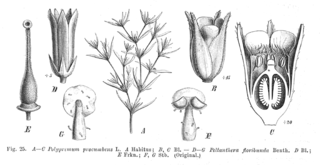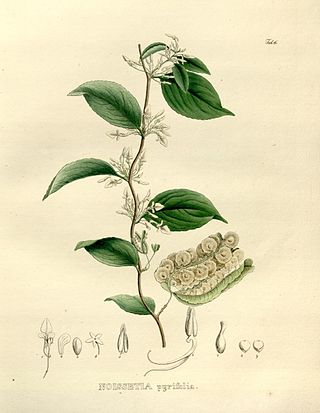
The Malpighiales comprise one of the largest orders of flowering plants, containing about 36 families and more than 16,000 species, about 7.8% of the eudicots. The order is very diverse, containing plants as different as the willow, violet, poinsettia, manchineel, rafflesia and coca plant, and are hard to recognize except with molecular phylogenetic evidence. It is not part of any of the classification systems based only on plant morphology. Molecular clock calculations estimate the origin of stem group Malpighiales at around 100 million years ago (Mya) and the origin of crown group Malpighiales at about 90 Mya.

Viola is a genus of flowering plants in the violet family Violaceae. It is the largest genus in the family, containing over 680 species. Most species are found in the temperate Northern Hemisphere; however, some are also found in widely divergent areas such as Hawaii, Australasia, and the Andes.

The Salicaceae is the willow family of flowering plants. The traditional family included the willows, poplar, aspen, and cottonwoods. Genetic studies summarized by the Angiosperm Phylogeny Group (APG) have greatly expanded the circumscription of the family to contain 56 genera and about 1220 species, including the Scyphostegiaceae and many of the former Flacourtiaceae.

Violaceae is a family of flowering plants established in 1802, consisting of about 1000 species in about 25 genera. It takes its name from the genus Viola, the violets and pansies.

Phyllanthaceae is a family of flowering plants in the eudicot order Malpighiales. It is most closely related to the family Picrodendraceae.

Ochnaceae is a family of flowering plants in the order Malpighiales. In the APG III system of classification of flowering plants, Ochnaceae is defined broadly, to include about 550 species, and encompasses what some taxonomists have treated as the separate families Medusagynaceae and Quiinaceae. In a phylogenetic study that was published in 2014, Ochnaceae was recognized in the broad sense, but two works published after APG III have accepted the small families Medusagynaceae and Quiinaceae. These have not been accepted by APG IV (2016).

Maesobotrya is a genus of flowering plants belonging to the family Phyllanthaceae. It was first described as a genus in 1879 and is native to sub-Saharan Africa. It is dioecious, with male and female flowers on separate plants.

Cordylanthus, commonly known as bird's beaks, is a genus of parasitic plants in the broomrape family, Orobanchaceae. These western North American natives are sparse, weedy-looking annuals with long branching erect stems and little foliage, and many bear bird's-beak–shaped flowers. They are remarkable among the broomrapes for growing at searing temperatures in arid climates.

Hybanthus (green-violet) is a genus of flowering plants in the family Violaceae. This genus name is Greek for "humpback flower", referring to the drooping pedicels of plants that are part of this genus. The genus is grossly polyphyletic and may contain up to nine different genera, of which Pombalia Vand., Cubelium Raf. and Pigea DC. have been previously recognised.

William Sole was a British apothecary and botanist.

The Amaryllidaceae are a family of herbaceous, mainly perennial and bulbous flowering plants in the monocot order Asparagales. The family takes its name from the genus Amaryllis and is commonly known as the amaryllis family. The leaves are usually linear, and the flowers are usually bisexual and symmetrical, arranged in umbels on the stem. The petals and sepals are undifferentiated as tepals, which may be fused at the base into a floral tube. Some also display a corona. Allyl sulfide compounds produce the characteristic odour of the onion subfamily (Allioideae).

Peltanthera is a genus of flowering plants containing a single species, Peltanthera floribunda. The genus was originally placed in family Loganiaceae and has since been variously placed in Buddlejaceae, Scrophulariaceae, Gesneriaceae, or in its own family Peltantheraceae. In 2016, it was considered by the Angiosperm Phylogeny Group to be unplaced in any family, but within the order Lamiales, while Christenhusz et al. in 2017 placed it in family Gesneriaceae as subfamily Peltantheroideae. The placement in Gesneriaceae was accepted by Plants of the World Online as of March 2024.

Isodendrion is a plant genus in the family Violaceae.

Schweiggeria is a genus of flowering plants in the violet family Violaceae, with one or two species, found in eastern Brazil.

Noisettia is a genus of flowering plants in the violet family Violaceae, with a single known species.

Calyptrion is a genus of flowering plants in the violet family Violaceae, with four known species.

Anchietea is a genus of flowering plants in the violet family Violaceae, with six accepted species, found in tropical South America.
Hybanthopsis is a genus of flowering plants in the violet family Violaceae, with a single accepted species, found in north-east Brazil.

Pombalia Vand. is a genus of flowering plants belonging to the family Violaceae.

Balabio Island is a small Pacific island of New Caledonia administered from Poum in the North Province.



















